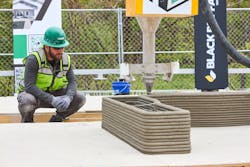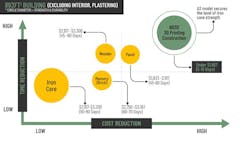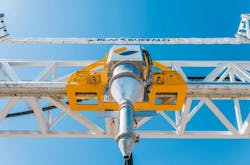How Black Buffalo Is Using 3D Printed Homes to Solve a Housing Crisis
Though still largely up-and-coming with a small but steadily rising market share, 3D construction is revolutionizing the home building industry, particularly amid a rampant affordability crisis exacerbated by a shortage of new housing. While 3D printing technology offers a range of prospective benefits both for builders and consumers, 3D printed homes—at least in their current preliminary stage—may not be a viable option for everyone. That’s something companies like Black Buffalo 3D are hoping to change.
Peter Cooperman, Black Buffalo’s former head of marketing and strategy and current interim CMO, recently discussed the role of 3D printed homes in solving the housing crisis during a virtual webinar. He explained how by reducing labor and build times associated with traditional residential construction, 3D printing offers a solution for home builders to expand their bandwidth while simplifying their projects.
Cost-Effectiveness
Black Buffalo 3D is revolutionizing the construction industry with its smart 3D construction printers (3DCP) from one to four stories, proprietary construction "ink" (Planitop 3D) and 3D print construction consulting services. Though the upfront cost of Black Buffalo’s machines and materials are higher than the average costs of traditional construction materials, the company argues that by reducing build time and labor, 3D printing can be a more cost-effective method of home construction.
The initial investment for 3D printed homes includes purchasing the printer, training the staff, and setting up the necessary infrastructure to begin printing. The NEXCON Gantry printers used by Black Buffalo are designed to reduce cost and time by building without breaks throughout several work days and under the supervision of only a handful of workers.
Black Buffalo partnered with MAPEI Corporation to develop a proprietary mortar called Planitop 3D, which can be activated with water. The mortar—composed of hydraulic binders, fiber, and aggregates—is shipped by the company to each individual jobsite, ultimately reducing material costs by 30% to 79% compared to traditional site-built construction, the company says.
Time vs. cost reductions of 3D printing materials compared with traditional construction materials
Image: Black Buffalo 3D
NEXCON printers can be rented, leased, or financed starting at $30,000 a month, including materials. While the initial investment is certainly far higher than the average rate to hire a general contractor, Black Buffalo argues that its potential for reduced labor, efficient material usage, and faster construction times can lead to significant cost savings in the long run.
READ MORE: Projects+Case Studies
Labor Savings
With an estimated shortage of over 723,000 workers as of June 2023, the construction industry is in need of efficient solutions to minimize labor output while satisfying consumer demand for much-needed housing. Here also, Black Buffalo shows us a solution.
In addition to material savings, 3D printing has the potential to reduce labor costs by streamlining operations, but rather than replacing jobs, companies that use Black Buffalo’s NEXCON printer employ a labor force to oversee operations and maintenance. The company currently estimates that due to that smaller building crew, it reduces labor costs by 50% to 80%.
“Older workers who would otherwise be aging out of the industry now have the opportunity to have a robot do a lot of the heavy lifting. A building crew working with a NEXCON printer starts with around just 4 or 5 people, but 3D construction is often used as a foundation and paired with traditional building methods. In that case, clients are still working with contractors who are familiar with this type of construction as well. We’re reducing the need for onsite labor while still opening up new positions and driving up the demand for people with building technology and material science knowledge.”
Black Buffalo's NEXCON printer requires only a handful of onsite workers, significantly reducing labor costs.
Image: Black Buffalo 3D
Time Efficiency
Total build time depends on the scale of each individual project, but according to Black Buffalo, residential homes are finished 50% to 80% faster with 3D printing technology, accomplishing in days what a full building crew would need weeks to complete.
“A 1,600 square foot house takes around 14 to 16 bags of Planitop 3D material. Our printers print at the maximum speed allowed by OSHA, which is around 33 hours of print time to construct every single wall for a 3D printed home.”
With the help of multiple crews on a jobsite, Black Buffalo can print continuously. The NEXCON printer takes an average of 2 minutes to complete one full lap around the house delivering one layer of Planitop mortar, which has a structural output “three times the psi of CMU block,” according to Cooperman.
Projected Growth
Black Buffalo estimates that the 3D construction industry is currently worth a total of $19.8 million but projects it to reach $477.1 billion by 2027, as government initiatives for more innovative housing solutions open the door for funding, collaboration, and wider consumer demand.
In 2022, President Biden released two initiatives aimed at utilizing 3D printing for localized manufacturing and closing the gap on affordable housing, and companies like Black Buffalo are poised to benefit from government investments meant to increase housing supply.
In the meantime, 3D printing companies are working to boost their credibility and gain wider industry acceptance with new building regulations and International Code Council Evaluation Service (ICC-ES) approval.
“The only globally recognized building criteria for 3D printed walls is called the AC-509 and is created by International Code Council Evaluation Service (ICC-ES),” says Cooperman. “Black Buffalo 3D is the first company that sells machine materials and uses 3D construction printing technology to be approved under that criteria.”
As more projects successfully adopt 3D construction printing, the associated costs are likely to become more manageable, which Cooperman hopes will eventually revolutionize the way the industry as a whole approaches new-construction in its efforts to boost supply.


